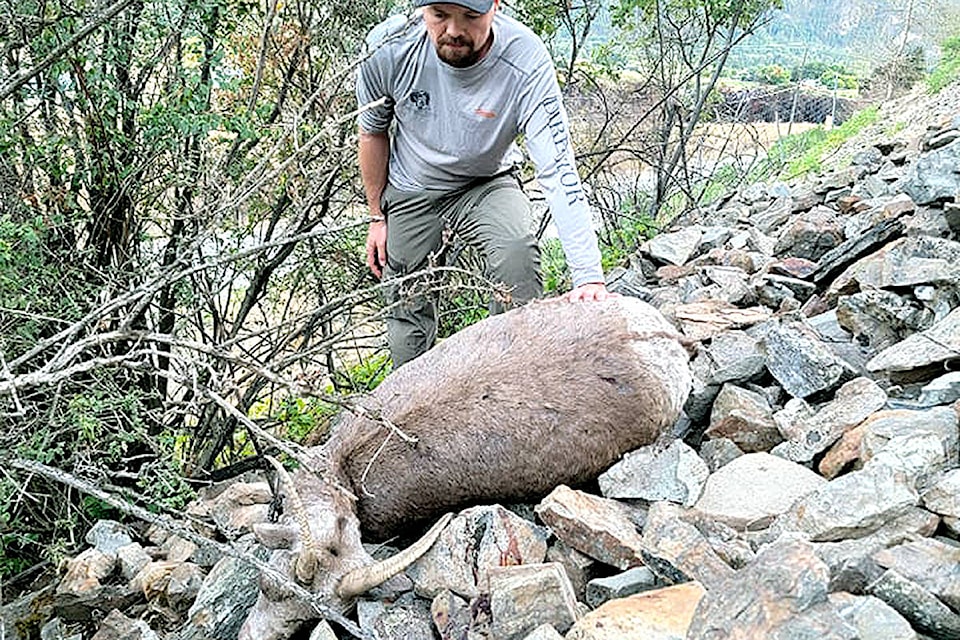A viral outbreak has decimated Grand Forks’ bighorn sheep population in what a wildlife veterinarian described as “a perfect storm” of hot weather and insect migration.
Preliminary tissue samples from some of the dead sheep suggest the culprit is a hemorrhagic disease known as Bluetongue, named after the swelling it causes in its oxygen-starved victims. Caely Thacker, a wildlife veterinarian with B.C.’s forest ministry, said she and her colleagues were waiting on confirmation from the Canadian Food Inspection Agency’s lab in Winnipeg as of Friday, Aug. 27.
The ministry hasn’t ruled out the closely related Epizootic Hemorrhagic Disease, generally known by the acronym EHD.
Twenty bighorns were found dead near Grand Forks Wednesday morning, Aug. 25. A further 10 had died by noon Monday, Aug. 30, according to Peter Gutsche, a director at the Wild Sheep Society of B.C. (WSS BC).
The death toll is likely to rise as society volunteers continue to search the area, Gutsche added.
Bluetongue can cause herd loss of between 60 and 90 per cent, he noted, going on to say he’d found dead nine out of 12 GPS-collared sheep locally monitored by WSS BC and the Wild Sheep Federation (WSF). He found 11 more dead sheep in the surrounding area. Thacker backed up Gutsche’s findings, which she said point to a herd loss of around two-thirds.
Bluetongue is a prolific killer of white-tailed deer in the United States and Southern Canada but is also known to kill free-ranging bighorns in the Okanagan and Kootenay areas, according to a BC Government fact sheet. The disease is spread by so-called “no-see-ums,” tiny biting flies that prefer the warm, dry temperatures that draw bighorns congregating around to watering holes every year between August and October.
Infected deer have been shown to lose their fear of humans and stop eating within a week of exposure. The disease causes extensive internal bleeding, causing infected animals to lose their balance. Death usually follows within two to three days of the onset of symptoms.
Speaking to conditions in the Grand Forks area, Thacker said, “It’s the perfect storm of there being less water on the surface for animals to drink and there being an insect source in the same place.” The Grand Forks herd was thought to be doing well, she continued, qualifying that implications for its long-term survival are “yet to be seen.”
Gutsche said a herd of around 30 bighorns was re-introduced in 1985 to a stretch of natural habitat east of the city. Their numbers had grown to around 200 at the time of the outbreak, he continued.
“There’s not much we can do about this other than to hope for a snap frost that will kill off the flies,” Gutsche said. The sheep’s habitat is owned by the Southern Interior Land Trust, thanks in large measure to a $107,000 contribution by the WSS BC.
The flies that carry the Bluetongue virus can’t survive overnight temperatures of around 0 C, Thacker told The Gazette. While there is no permanent population of their species in Canada, she explained the flies are borne on winds from parts of the United States where the virus is endemic. This means the virus could be re-introduced to the Boundary if new generations of flies are blown back in future summers, she explained.
BC WSS will continue to monitor the situation with the WSF, Gutsche said. “The first step is to determine how many animals are left,” he explained.
The virus that causes Bluetongue does not affect humans, but it can infect some domestic animals. Domestic animals infected with the virus typically don’t develop the disease, according to the province’s fact sheet.
@ltritsch1
laurie.tritschler@grandforksgazette.ca
Like us on Facebook and follow us on Twitter.
laurie.tritschler@boundarycreektimes.com
Like us on Facebook and follow us on Twitter.
